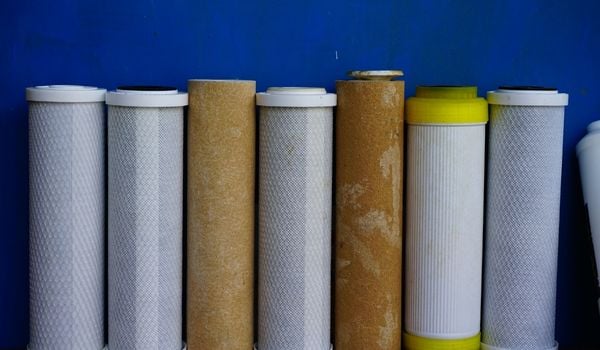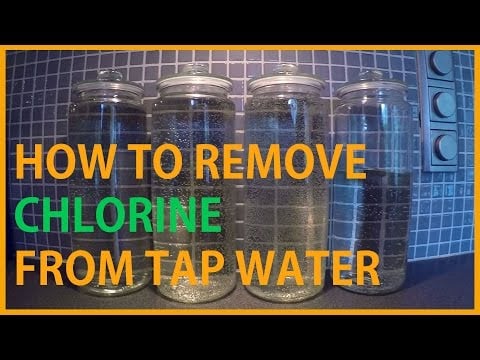If your tap water smells like a swimming pool, chlorine is the usual suspect. It’s a strong disinfectant that keeps your drinking water safe — but let’s be honest, it’s not exactly delicious.
Municipal water systems add chlorine to kill bacteria and viruses as water travels to your faucet. The problem? That sharp taste and smell often lingers longer than you’d like.
💡 But here’s the good news: you’ve got options — and most of them are easier (and cheaper) than you think. From boiling to carbon filters to full-on reverse osmosis systems, this guide breaks down seven simple ways to reduce chlorine — plus one bonus tip if your water suddenly smells extra funky.
⚡ Quick Takeaways
- 🔥 Boil it out – Letting water simmer for 10–15 minutes helps chlorine gas escape naturally.
- 🍊 Use Vitamin C – Ascorbic acid (yup, like in oranges) instantly neutralizes chlorine in small batches.
- 🧱 Install a carbon filter – One of the most effective ways to zap chlorine taste from every glass.
- 🚰 Go reverse osmosis – Best for households with lingering chlorine and other contaminants.
- 🧪 Know why it’s there – Chlorine’s job is safety, not flavor. But too much isn’t ideal for taste (or your skin).
- 📞 Bonus Tip – A spike in chlorine taste? Could be a city water issue — call your supplier before troubleshooting.
🦸♂️ Why Is Chlorine Even in My Tap Water?

Okay, so it might smell like a public pool, but chlorine’s not the villain here — it’s actually doing some heavy lifting behind the scenes.
Since the early 1900s, water treatment plants have used chlorine to knock out germs like bacteria, viruses, and parasites. It keeps water safe as it travels through miles of pipes to reach your glass.
💡 That faint chemical taste? It’s just a side effect of protection. Chlorine hangs out in your water on purpose — to keep it clean all the way from the plant to your faucet.
🧪 What Chlorine Does:
- 🦠 Disinfects your water to make it safe to drink
- 💧 Prevents regrowth of bacteria inside your pipes
- 🛡️ Keeps your supply stable even if water sits in the system for a while
💡 Good to know: The EPA allows up to 4 ppm (parts per million) of chlorine in municipal water — enough to kill germs without harming you. But that doesn’t mean it’ll taste good.
🔥 Option 1: Boil It Out

Boiling tap water is a classic, no-frills way to remove chlorine — and it still holds up today. Just heat your water for around 10 minutes, and the chlorine gases off naturally. No filters, no fancy systems — just you and a stovetop.
| ✅ Pros | ⚠️ Cons |
|---|---|
| Easy and affordable — no equipment needed | Not ideal for large quantities |
| Removes both chlorine & chloramines | Water needs time to cool |
| Perfect for cooking water or small batches | Energy use can add up if done often |
💡 Pro Tip: Keep the pot uncovered while boiling — it speeds up chlorine evaporation. This trick works best for free chlorine, not chloramine blends (which take longer to break down).
🧲 Option 2: Activated Carbon Filters
Activated carbon filters are the go-to for most households — and for good reason. These filters use adsorption (yep, with a “d”) to trap chlorine molecules on the surface of the carbon, leaving your water clean, crisp, and far less chemical-tasting.
| ✅ Pros | ⚠️ Cons |
|---|---|
| Removes chlorine, VOCs, and weird odors | Needs regular cartridge replacement |
| Improves taste and smell noticeably | Effectiveness depends on filter quality |
| Easy install — no plumber required | Doesn’t remove chloramine unless labeled |
💡 Good to Know: Look for NSF-certified activated carbon filters — they’re tested for performance. Need a solid home option? Start with a quality under-sink filter system or check out how activated carbon filters work.
🔬 Option 3: Reverse Osmosis Systems
If you want the full-package solution — not just for chlorine but for dozens of other waterborne contaminants — reverse osmosis (RO) systems are where it’s at. These systems combine multiple filtration stages (including a carbon pre-filter) and a semipermeable membrane to catch almost everything.
| ✅ Pros | ⚠️ Cons |
|---|---|
| Removes chlorine, lead, fluoride, nitrates, and more | Higher upfront cost compared to basic filters |
| Built-in carbon stage targets chlorine specifically | Requires occasional maintenance and filter swaps |
| Great for cooking, coffee, baby formula, etc. | May reduce beneficial minerals like calcium |
💡 Good to Know: RO is ideal if your water has more than just chlorine to worry about. It’s also one of the few options that works on stubborn chloramine. For more, see our reverse osmosis system guide.
💊 Option 4: Dechlorination Tablets (Vitamin C)
If you’re looking for a grab-and-go way to neutralize chlorine — no plumbing, filters, or hardware required — dechlorination tablets might be your best friend. Most are made from vitamin C (ascorbic acid) and work instantly when dropped into water.
| ✅ Pros | ⚠️ Cons |
|---|---|
| Neutralizes chlorine *and* chloramine | Not ideal for daily, large-volume household use |
| Portable — great for camping, travel, or emergencies | Ongoing cost if used frequently |
| No installation or gear required | Doesn’t remove other contaminants |
💡 Good to Know: Vitamin C works fast and doesn’t affect water pH. Just be sure to follow dosage instructions carefully — especially for small containers like fish tanks or pet bowls.
☀️ Option 5: UV Light & Other Quick Fixes
If you’re already using a UV disinfection system, you might be surprised to learn it can also help reduce chlorine — especially when paired with other methods. And if you’re in a pinch, there are even simpler ways to dechlorinate a glass or jug of water.
| ✅ Pros | ⚠️ Cons |
|---|---|
| UV systems can weaken chlorine bonds over time | Not a standalone chlorine removal method |
| Vitamin C (ascorbic acid) powder works fast | Not ideal for treating large volumes daily |
| Simple options for travelers or renters | Less comprehensive than filtration systems |
💡 Good to Know: A pinch of crushed vitamin C or a UV pre-treatment step can help improve the effectiveness of downstream filters. These hacks are great for smaller jobs — or as backups if your main system needs service.
▶️ Video Tutorial:
🧼 Water Filters That Actually Work

Not all filtration methods are created equal when it comes to kicking chlorine to the curb. Let’s break down the ones that consistently get the job done — whether you want something quick and simple or full-blown protection.
| 🛠️ Filter Type | 🔍 What It Does | 💡 Best Use |
|---|---|---|
| Activated Carbon | Traps chlorine and other chemical compounds through adsorption | Great for taste and odor issues in everyday tap water |
| Reverse Osmosis | Removes chlorine, chloramine, heavy metals, and more | Ideal for households with multiple water quality concerns |
| Undersink Filters | Often combine carbon + sediment filters for clean-tasting water on tap | Perfect for drinking and cooking without altering your whole-home system |
💡 Good to Know: You don’t always need a full-on system to enjoy better water. If chlorine is your only complaint, a compact filter under the sink or on the faucet can bring big results without the plumbing overhaul.
☎️ Bonus Move: Call Your Water Provider
Sometimes, the weird chlorine taste isn’t coming from your pipes — it’s coming from the source.
City water systems aim to keep chlorine levels balanced — strong enough to kill germs, but not so strong it smells like a swimming pool. But hiccups happen.
- 🧪 For example, a stuck chlorine injector or sudden maintenance on a water main can lead to a spike in the chlorine concentration hitting your tap. That’s not super common, but it’s definitely possible.
💡 Good to Know: If your tap water suddenly starts tasting or smelling heavily chlorinated — and your filter isn’t fixing it — a quick call to your local water authority might reveal the reason. They can tell you if there’s been a treatment adjustment or equipment glitch on their end.
👉 Don’t assume it’s your filter or your plumbing until you rule out the source.
🧠 FAQs You Might Still Be Wondering

❓ Is chlorinated water safe for fish tanks?
Nope — even small amounts of chlorine can harm fish and kill off the beneficial bacteria in your tank’s filter. Always dechlorinate first, either by letting the water sit out, using ascorbic acid, or grabbing a tap water conditioner from your local pet store.
❓ Does chlorine harm houseplants or gardens?
Not really. Some soil bacteria might take a hit, but they bounce back quickly. Most plants won’t notice. That said, if you’ve got finicky greens or you just want to be extra gentle, dechlorinating before watering won’t hurt.
❓ Are chlorine and chloramine the same thing?
Close, but not quite. Chloramine is a blend of chlorine and ammonia. It’s used in some cities as a longer-lasting disinfectant, but it’s harder to remove than chlorine. Standard carbon filters can struggle with it — RO filters or catalytic carbon are better bets.
❓ Should I dechlorinate water for pets?
Tap water is generally safe for pets, but some animals (like dogs) might notice the taste. If yours turns up their nose, switch to dechlorinated water — they’ll thank you with extra tail wags.
 113 people found this helpful. Was this guide helpful to you?
113 people found this helpful. Was this guide helpful to you? 


